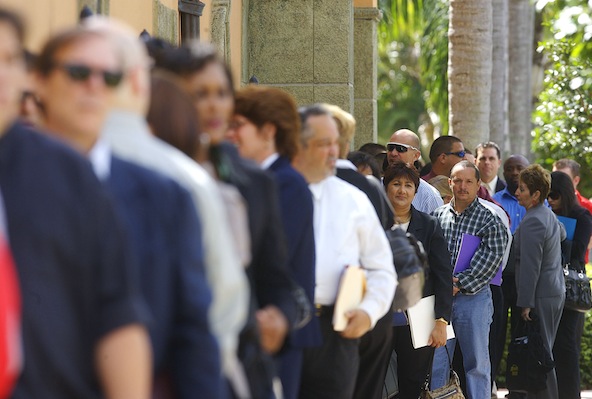Unemployment Rate Rises to 9.6 Percent
“The turnaround has been insufficient, Christina Romer, the exiting chair of the Council of Economic Advisers, said this week. The economy is growing, but not fast enough to create the hundreds of thousands of jobs each month needed to return employment to its pre-crisis level.”
Jul 31, 2020181.1K Shares2.5M Views
People in line for a job fair in Ft. Lauderdale, Fla. (Michael Francis McElroy/ZUMA Press)
This morning, the Department of Labor announcedthat the unemployment rate climbed from 9.5 percent in July to 9.6 percent in August, as economy-wide lack of demand kept businesses from hiring new workers. Some economists expected a worse report, and the August data offers more evidence of a stall-out in the recovery.
[Economy1] The report indicated that total employment declined by 54,000, with 121,000 jobs lost from the public sector and 67,000 jobs gained in the private sector. The federal government shed workers as the census finished up. The number of long-term unemployed — workers out of a job for more than six months — declined from 6.6 million to 6.2 million. The long-term unemployed make up 42 percent of unemployed persons, down from 44.9 percent in July.
Economists feared a worse report — with private-sector job growth beating forecasts by 20 to 50 percent. For the first time since 2007, the unemployment rate improved year-on-year. But the rising unemployment rate remains evidence of a lagging recovery. Stimulus funds are drying up. Joblessness is pervasive, meaning lower sales for companies. Business owners are concerned about economic conditions, and therefore are loath to hire new workers. Since December, 2009, the private sector has added 763,000 jobs — 95,375 a month — but to keep up with population growth, the United States needs to add about 125,000 positions per month. To return to full employment in five years, the economy needs to add 300,000 a month, every month. The United States has added just 3.4 million net new jobs since January 2000, though the country has grown by 29 million people.
In the past few months, the White House has focusedon private-sector job creation as evidence of “recovery summer,” though the unemployment rate remains stubbornly high. Some economists inside and out of the administration have declared the jobs trend evidence of the need for new government stimulus to make up for a lack of private demand.
Leaving her post as the head of the White House’s Council of Economic Advisers this week, Christina Romer declaredthe turnaround “insufficient.” The economy “is growing, but not fast enough to create the hundreds of thousands of jobs each month needed to return employment to its pre-crisis level.”
“The only surefire ways for policymakers to substantially increase aggregate demand in the short run are for the government to spend more and tax less,” Romer argued. “In my view, we should be moving forward on both fronts.”
The White House is reportedlyconsidering new measures to help gin up new jobs in advance of the November elections. But it will likely focus on less-stimulative tax cuts, rather than more-stimulative spending measures. (The most effective forms of stimulus are food stamps and unemployment benefits, which go directly to the neediest citizens and are spent almost entirely, immediately.) Senate Republicans and Sen. Ben Nelson (D-Neb.) have indicated they will support no additional stimulus funds.
However, Republicans have said they support tax breaks, and even might not require spending offsets. Recently, Republicans such as Sens. Jon Kyl (Texas) and Mitch McConnell (R-Ky.), the minority leader, have arguedthat spending increases, but not tax cuts, need to be offset with spending cuts.
The administration is reportedly considering pushing for a payroll tax holiday. The tax cut would be temporary, to encourage businesses to hire quickly to take advantage. The Congressional Budget Office this winter found payroll tax holidays to be among the more effective tax cuts in creating jobs and aiding the economy. According to the CBO, a payroll tax cut is about 25 to 33 percent more stimulative than providing a refundable tax credit for lower- and middle-income households, for instance.
And the economy is in need of more aid to help restart the recovery, with the jobs report containing broad evidence of a stall out. The number of unemployed persons — workers without a job, but actively seeking a new one — increased from 14.6 million to 14.9 million. The number of workers employed part-time who want to work full time increased by more than 330,000 over the course of the month.
The sustained, high rate of joblessness is also suppressing wages for working Americans. Most of the job growth since the recession ended has come not from middle-class or well-salaried positions, but in jobs like home health aide that often come with about $9 an hour and no benefits.
“[T]he damaging effects of high unemployment are not just felt by the workers (and the families of workers) who have lost jobs,” Lawrence Mishel and Heidi Shierholz of the Economic Policy Institute wrotethis week. “Workers who have kept their jobs or found new work during this downturn have also suffered from a broad-based collapse of wage growth over the last two years. And with unemployment expected to remain elevated for many years to come, we do not expect the suppression of wage growth to ease anytime soon.”

Rhyley Carney
Reviewer
Latest Articles
Popular Articles
